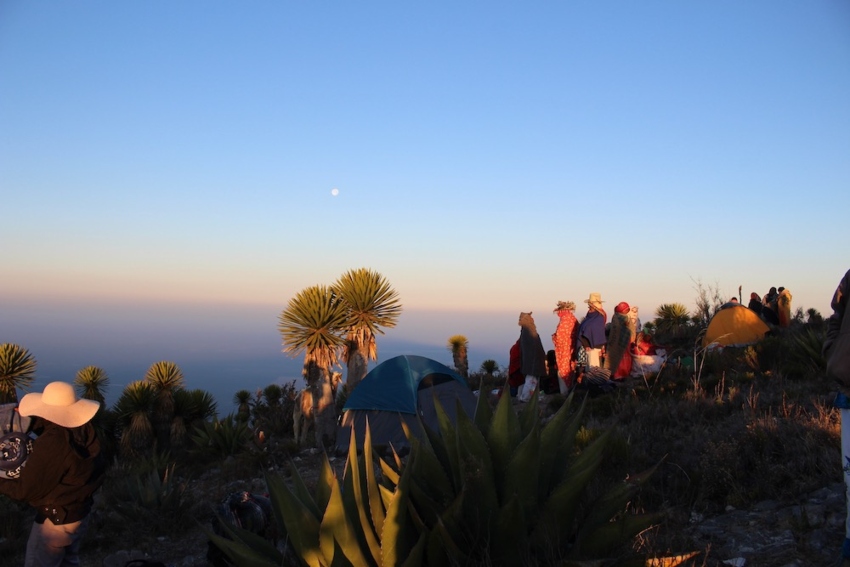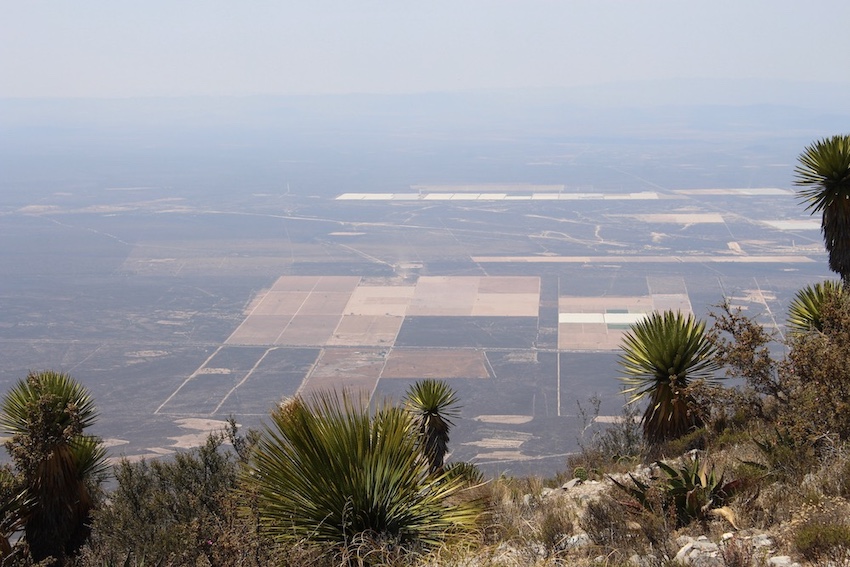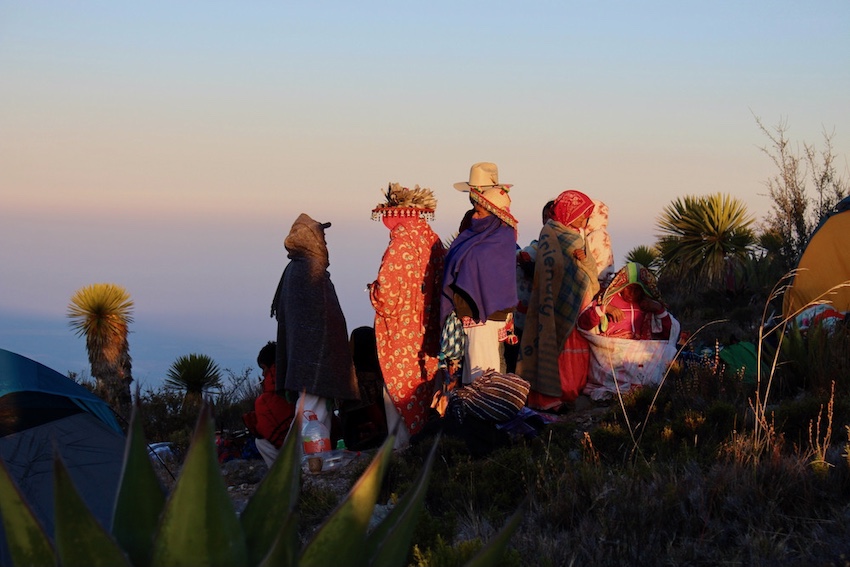Dawn takes its time in the Chihuahuan desert. By the time the first light brushes the hills above Wirikuta, Wixárika pilgrims are already moving, with gourd bowls and candles in hand, and stories carried in footsteps along a 500-kilometer thread of sacred sites that ties mountains to springs, desert to sea, and families to their ancestors. Last month, UNESCO wove that thread into World Heritage.
The next chapter is less poetic: governance, access agreements and enforcement where fences, factory farms and mining concessions have eroded the landscape, strained aquifers and frayed a living tradition.
Leer esta historia en español AQUI

The trail to the semi-desert reserve known as Wirikuta — to the Wixárika, the Birthplace of the Sun — stretches across five states, marked by sacred springs and hills and shrines. The designation is the first such honor in Latin America for a living Indigenous tradition. What that recognition means on the ground and how an ancient ceremony meets modern Mexico’s laws, land uses and pressures, has been the focus of much discussion since the decision was announced.
The many threats to Wirikuta
Wixárika land defenders and their allies have long fought an onslaught of threats to their sacred sites, from mining to industrial agriculture to illegal peyote extraction. They hope the international recognition will take protection efforts to the next level.
But the desert is already under siege, with explosive growth in industrial agriculture, and government response has been inadequate. In a desert where aquifers are already at the red line, unchecked expansion undercuts the very values UNESCO just recognized.
An even bigger threat looms, too. Nearly 80 mining concessions have been granted that cover more than two-thirds of the Wirikuta Natural Protected Area, and while a court order has put them on hold, the injunction is provisional. The titles remain on the books, and because Mexico’s 2023 mining reform did not revoke existing concessions, operations could resume.
Who are the Wixárika?
The Wixárika (or Huichol) are an Indigenous people of the Western Sierra Madre in Jalisco, Nayarit and Durango. They maintain their language, communal governance and a rigorous ceremonial calendar led by mara’akate (spiritual guides). Each year, pilgrims travel the well-worn paths, leaving offerings at sacred sites along the way and culminating in Wirikuta, one of the most biodiverse desert landscapes in the world. Wirikuta is their most sacred temple, the place where they pray with their sacred plant, the “hikuri” or peyote cactus, for guidance and for the well-being of all life on Earth.
For the Wixárika, the stakes are both spiritual and practical. “By keeping these sacred places alive, we keep the culture alive,” says Aukwe Mijares of the Wixárika Regional Council in Defense of Wirikuta.

UNESCO’s vote recognized that places like mountains, springs and even footpaths can have Outstanding Universal Value. Meaning, the same cultural weight as a cathedral.
“People said, ‘Why rescue the right-of-way, the traditional route? People can just take a car,’” says Humberto Fernández, founder of Conservación Humana and a lead architect of the nomination. “But this was also a demand from the elders — they told us, between the Sierra and Wirikuta there are many important sacred places. And the old walking routes are also very important to us.”
He compared the route with Spain’s Camino de Santiago, the first UNESCO-designated pilgrimage path, which the Wixárika Route now joins as the latest in a small family of inscribed cultural routes.
What UNESCO recognition does — and doesn’t do
Recognition brings attention and obligations. Mexico must set up a representative oversight committee, approve a workable safeguarding plan, and file regular reports on the route’s condition. The spotlight also adds outside scrutiny. UNESCO can ask for follow-up and publicly flag backsliding, which can stiffen enforcement of protections that already exist.
Mexico is a party to the legally binding Convention Concerning the Protection of the World Cultural and Natural Heritage. “The inscription obligates the government to safeguard the route’s Outstanding Universal Value, stating that each State Party should use all its legal framework and institutional capacity to protect the Outstanding Universal Value of each site,” said Fernández. UNESCO sets the standards and monitors compliance through periodic and reactive reports, advisory missions, and, if needed, even delisting.
What it does not do is override Mexican law or cancel mining titles, greenhouses or other permits; nor does it replace day-to-day enforcement by federal, state and municipal authorities. It doesn’t, by itself, protect every place that matters. And while UNESCO can provide technical support and very limited funds, the budget and day-to-day management must come from the Mexican government.

Observers say real change will come from how authorities apply Mexican law, administering protected-area decrees, environmental impact statements, and water and land-use rules, and from cooperation with landowners and communities. To date, enforcement has been thin. The hope is that the added leverage of international attention helps tip the balance.
“In UNESCO’s recommendation, the very first point is that there must be no mining concessions,” notes Wixárika spokesperson Aukwe Mijares. “That gives us hope — so protection actually happens on the ground.”

What the UNESCO listing requires now
The UNESCO designation comes with concrete obligations that Mexico must fulfill to maintain the route’s World Heritage status. The detailed action plan touches everything from an oversight committee to on-the-ground enforcement.
- Seat a real governance structure with Indigenous participation. The Mexican government must finalize a coordinating body that ensures Wixárika participation and protects the route’s Outstanding Universal Value and key attributes.
- Establish a Management Unit and deliver a workable plan. Mexico must establish the Management Unit and implement an Integrated plan that covers conservation, safeguarding, access, and enforce strict, culturally appropriate visitor management where it comes into contact with tourists.
- Mexico should name exactly what’s protected (sites, crossings, the living pilgrimage) and align cultural-heritage, environmental, land-use and water rules.
- Secure right-of-way and manage access through private lands. The evaluation flags fences and property demarcations that block pilgrims; it urges negotiated access agreements and consistent enforcement.
- Address key threats with monitoring and enforcement. Mining (including new interest near San Luis Potosí), vast expanses of greenhouses for tomato production, factory farms, peyote extraction and urban growth are cited as the main pressures.

What Wixárika leaders are asking for
While UNESCO’s requirements provide a framework, Wixárika leaders have their own priorities, many of which go beyond what the international body mandates. Their demands, shared through a statement released by the Wixárika Regional Council, reflect decades of struggle against encroachment on sacred lands and a clear vision for what meaningful protection looks like.
- Make the mining suspension permanent. Wixárika authorities and the Wixárika Regional Council have repeatedly demanded cancellation of the 78 concessions affecting Wirikuta.
- Elevate protection to the federal level. Leaders want the Wirikuta Natural Protected Area — currently state-level in San Luis Potosí — to be moved to federal status to close loopholes and strengthen enforcement.
- Tie UNESCO to real alternatives for locals. Provide dignified, sustainable livelihoods for residents so they aren’t pushed into agribusiness or extractive projects on sacred lands.
- Strengthen protection of hikuri (peyote). Increase enforcement against harvest and trafficking by non-Wixárika groups, and support public education that peyote is sacred and slow-growing.
- Adopt a general policy to protect cultural and natural heritage in regional planning and development programs, developed with the participation of local residents and the Wixárika people.
- Fund science and monitoring. Carry out adequate scientific and technical studies to identify risks to sacred places (e.g., spring/aquifer baselines, peyote population surveys, impact assessments) and use those findings to guide action.
- Back it with tools and money. Adopt the legal, scientific, technical, administrative and financial measures needed to conserve the sites — e.g., aligned decrees and access agreements, a staffed site manager/management unit, clear procedures and a dedicated budget.
What longtime observers and defenders say to watch

Beyond official requirements and community demands lies the question of implementation. The nitty-gritty details that will determine success or failure. Environmental researchers, legal advocates and those who’ve spent years defending these lands point to specific pressure points that will reveal whether Mexico is serious about protection.
- Follow the water (and the basins). Researchers are seeing large water demands for industrial agriculture and link dried springs and lagoons to cumulative pumping, greenhouse expansion and road cuts. Mining, if allowed, would require vast water inputs. Impacts must be measured at the watershed scale, they say, not just as dots on a map.
- Point-by-point work at all 20 inscribed places. The International Council on Monuments and Sites (ICOMOS) recommends transparent, site-specific actions and public updates so communities can track progress in each of the disparate areas identified on the route.
- Enforce existing decrees and stop illegal land uses. Calls include halting destructive agro-industrial practices, removing illegal barriers on communal lands and upholding the right-of-way to sacred sites.
- Access, fencing, and fragmentation. On-the-ground defenders cite illegal fencing and road grading that dry soils, block wildlife (including white-tailed deer, the most sacred animal for the Wixárika people), and cut historic passages — in particular, a 4-kilometer illegal fence in Las Margaritas that could prove a litmus test for whether the inscription has teeth.
- Set up a process to add additional sites that were not included in the current list. The inscription covers 20 places, but key sites remain outside. Most notably, Xapawiyemeta (Scorpion Island) in Lake Chapala, one of the Wixárika’s five sacred directions.
- Get the commission right. Scholars emphasize that the listing only works if a representative commission is seated, and the management plan truly reflects a living route, not a static monument.
What happens next
After the applause, making World Heritage real is mostly about process. Who sits at the table? How are decisions made? Do the protections written on paper show up on the land as open trails and flowing springs?
The Wixárika have kept this tradition alive across centuries of change. UNESCO’s inscription gives them one more tool. Whether it works will be evident not in a plaque, but in the landscape. It will be in a route that remains passable, a desert that continues to bloom, waters that continue to flow, and a people that can keep walking toward the sun.
Tracy L. Barnett is a freelance writer based in Guadalajara. She is the founder of The Esperanza Project, a bilingual magazine covering social change movements in the Americas.
